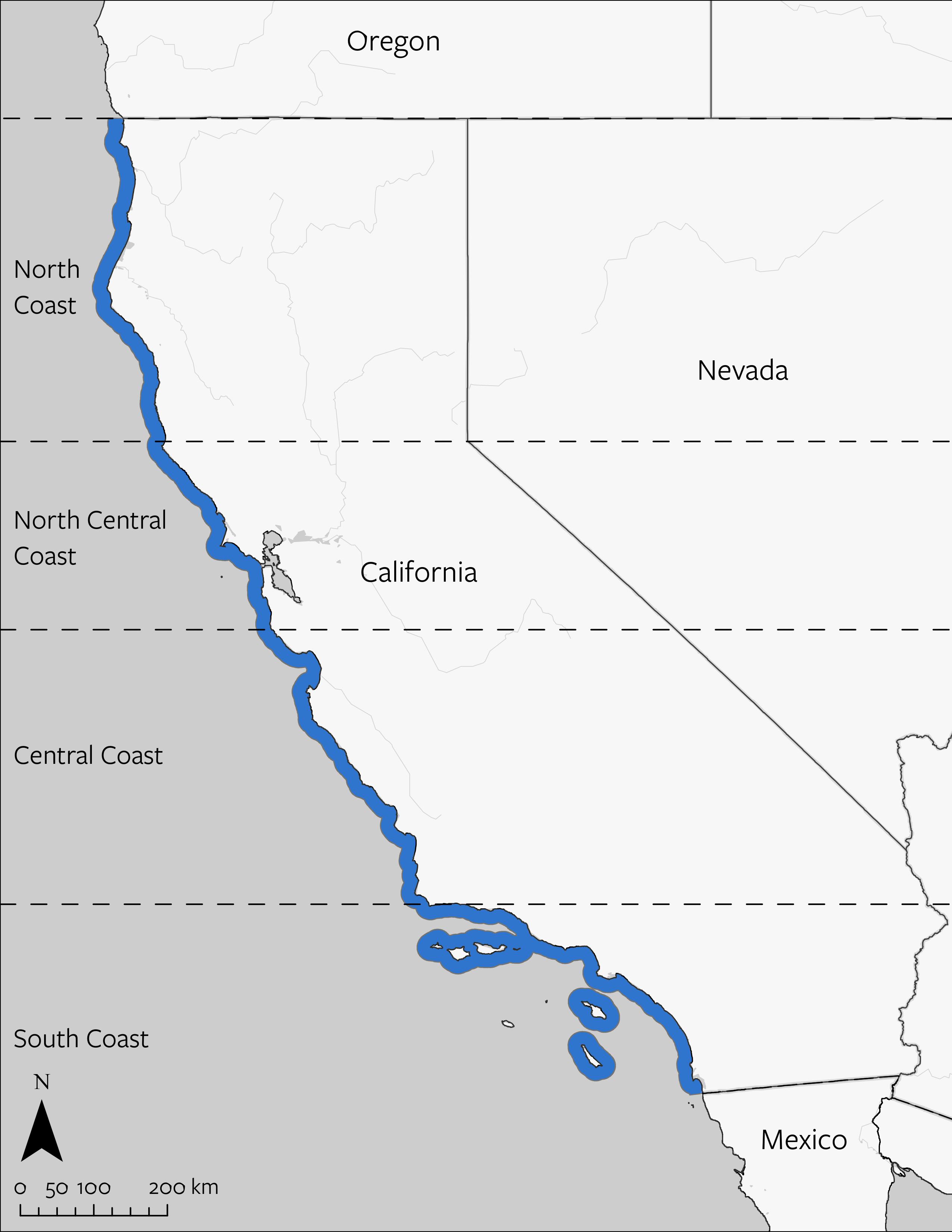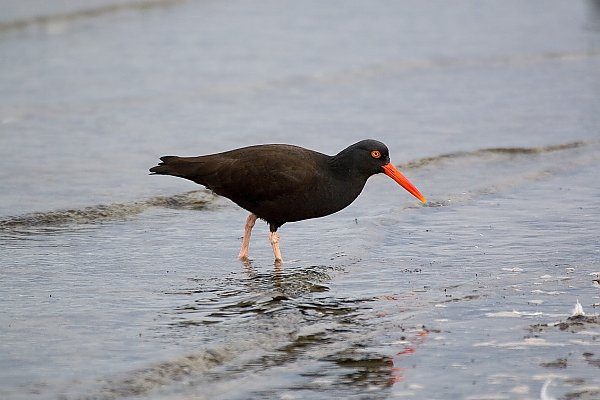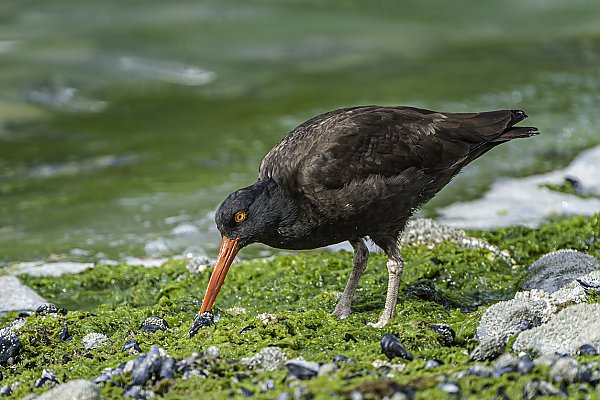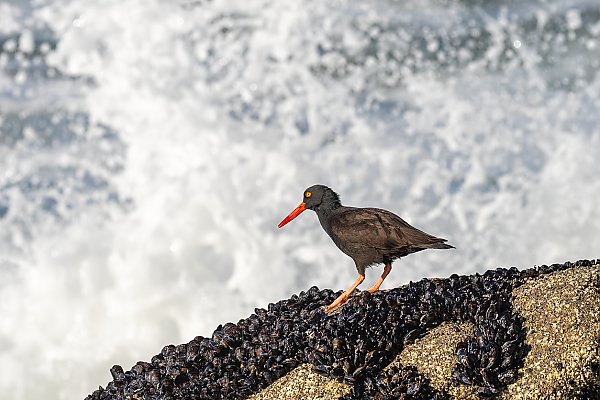Black Oystercatcher
Haematopus bachmani
Black Oystercatcher
Haematopus bachmani
Black oystercatchers are vulnerable to several threats and are a USFWS Focal Species for Conservation Action.
Morphology
Often observed in pairs on rocky shorelines, the black oystercatcher is a large, heavyset shorebird with a long, thick straight bill. They are almost totally dependent on the narrow, intermittent band of rocky intertidal habitats. The adults are blackish, with dark brown wings, tails, and backs, with an orange-red bill and yellow eyes ringed with red. These intertidal birds will take flight to avoid the crashing surf, occasionally releasing very loud, ringing whistles that are easily heard above the sound of the waves. The black oystercatcher is roughly crow-sized, with a length of 40 to 47 centimeters, a weight between 0.5 and 0.7 kilograms, and a lifespan of more than 15 years.
Habitat and Range
The black oystercatcher can be found on rocky shorelines and sea islets, especially those on small offshore islands with fewer predators. Oystercatchers prefer areas with abundant shellfish and other marine life, such as tidepools. South of Alaska, they are mostly permanent residents with no regular migration. In winter, many leave their nesting territories and are commonly found on mudflats and river mouths close to rocky shorelines. Their range extends from Alaska to Baja California, but they are scarcer along Southern California coasts where the shoreline is mostly sandy, not rocky. They are found on all five islands of the Channel Islands National Park.
Range Map

Reproductive Biology and Life History
Black oystercatchers almost always nest on islands, on the ground above the high-tide mark on rock depressions, gravel, or grass. Pairs mate for life. As breeding season approaches in the spring, the pair will perform paired flight, and walking displays with much calling. A pair will establish and defend a breeding territory that includes an elevated area for nesting and an adjacent foraging area. Males will make multiple scrapes on the ground for the female to select. Once a scrape is selected, both sexes may toss rock flakes, pebbles, and shell fragments toward their nest with a sideways or backward flip of their bills. The size of the nest varies, with an average of 8 inches across and 1 inch deep. Each clutch has around 2-3 eggs of a pale to olive color that are incubated by both parents over 24-29 days. The chicks can walk shortly after hatching and fledge at about five weeks. Adults feed their young and teach them foraging skills for several months after fledging.
Ecology
Despite its name, the black oystercatcher rarely eats oysters. Instead, they mostly feed on mussels, limpets, and other shellfish. Black oystercatchers also eat whelks, urchins, crabs, marine worms, and beetle larvae. They forage mostly near low tide and rest and preen in roosts of a dozen or more at high tide. When feeding on bivalves, they have two methods of opening the shells. If the mussel is slightly open, the oystercatcher quickly jabs the abductor muscle that holds the shell closed, disabling the mussel, before pulling out the contents with the tip of their chisel-like bill. If the mussel is not open, the oystercatcher hammers on the shell to break it open.
Cultural Significance and Historical Context
Black oystercatchers can be found along much of the California coast, though their population has declined compared to historical levels. Because black oystercatchers breed diffusely, they do not lend themselves to efficient counts centered on prime nesting sites. Boat-based survey have been used, but counts from boats were typically done later in the season, when black oystercatchers are less vocal and less visible. To fill major gaps in our knowledge regarding oystercatchers in California, from 2012 to 2022, a focused public/private monitoring effort took place providing a baseline of their status for the future. Hundreds of dedicated trained amateur ornithologists teamed with professional biologists to study the nest success of black oystercatchers. Observers interacted with thousands of coastal visitors, letting them view the chicks through spotting scopes and giving them magnets that read “Who is this rock star bird?”
Date modified: January 2025
Primary ThreatsPrimary Threats Conditions
Threats and Conservation Status
Despite being locally common along parts of Pacific shorelines, black oystercatchers are considered globally uncommon. They have an estimated global population of 12,000-17,000 individuals with higher densities in parts of Alaska, British Columbia and Central California (Sonoma to Monterey). A recent 10-year study showed that nest success increased from south to north, suggesting northern areas could serve as a source for southern areas. Because there is a paucity of long-term monitoring data with known search effort, we were restricted to a 21-year study conducted at Vandenberg Space Force Base in Santa Barbara County. In this location the population is increasing at nearly 2% per year, a trend that explains 26% of the total year-to-year variation between 2000 and 2021. This increase is in line with shorter term observations from other regions of California – most notably the citizen science effort, as well as stage structured population models based on published survival and reproduction rates.
The species is completely dependent on marine shorelines and thus more vulnerable to the impacts of oil spills and other pollution in intertidal zones. Like other shorebirds, the black oystercatcher is extremely vulnerable to disturbances at nesting sites. The species is considered climate-endangered because of its small population size and dependence on narrow rocky intertidal habitats for foraging and nesting, making them vulnerable to sea level rise and increased storm intensity and frequency. Due to small population size, limited range, threats to preferred habitat, a lack of baseline data to assess conservation status, and other natural and anthropogenic factors, the U.S. Fish and Wildlife Service (USFWS) selected the black oystercatcher as a Focal Species for Conservation Action.
Population Plots


Data Source: These data were collected by Point Blue Conservation Science, which is a nonprofit organization dedicated to using science in service of conservation and natural resource stewardship (see pointblue.org).



